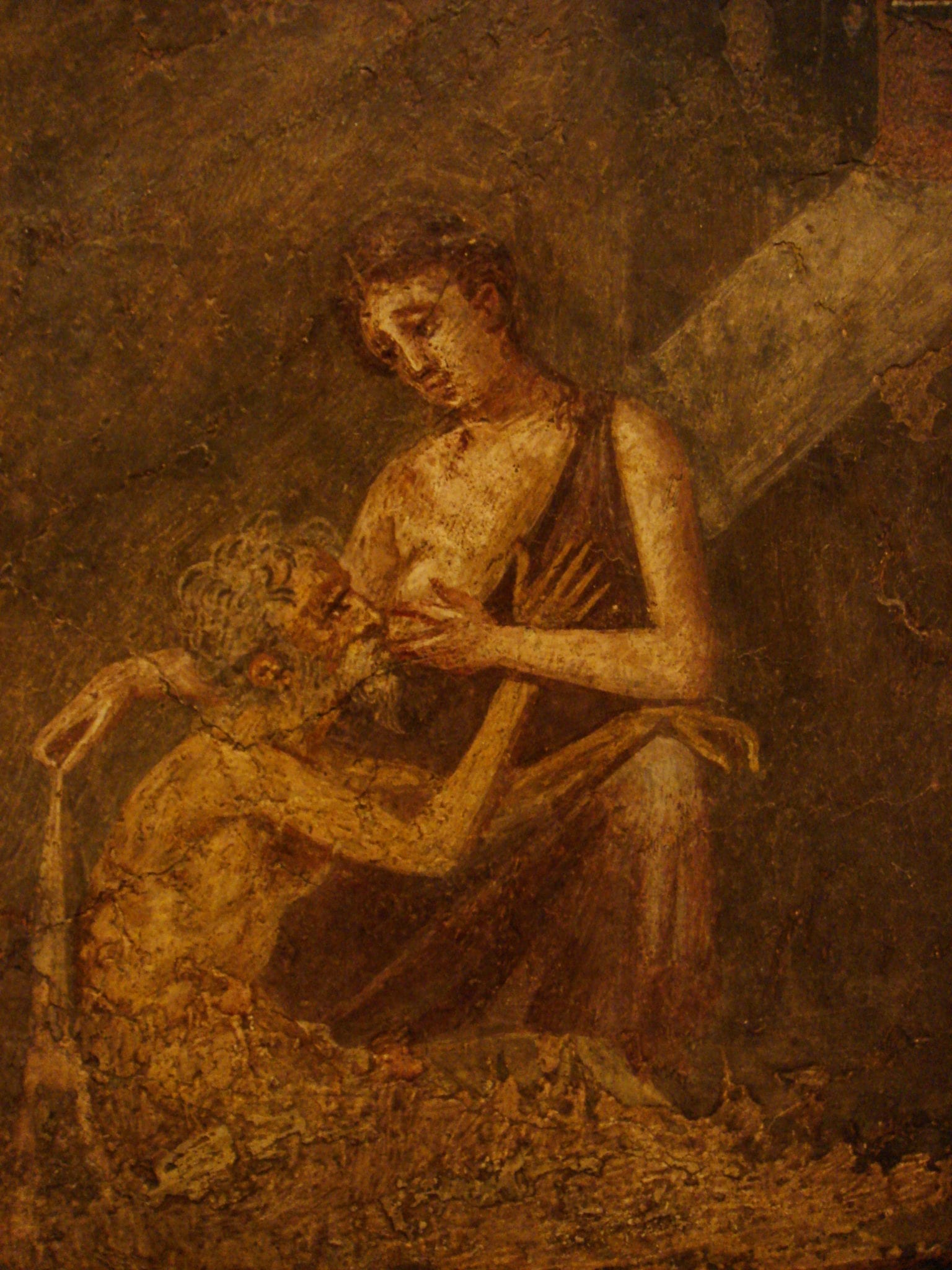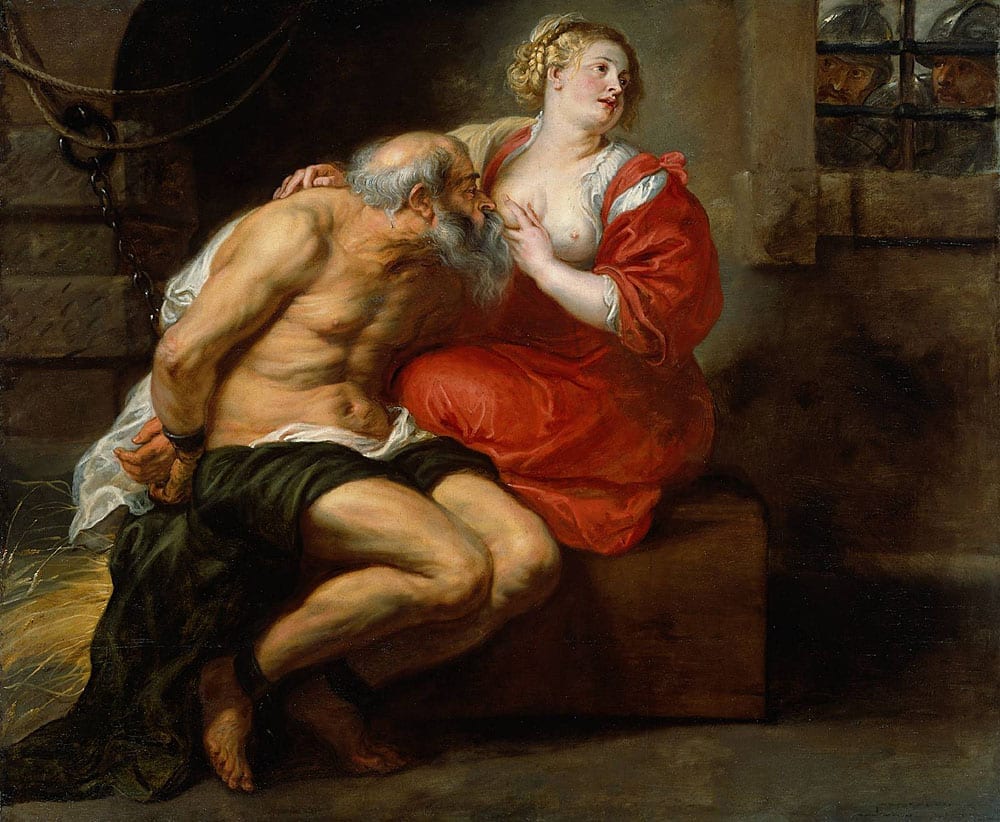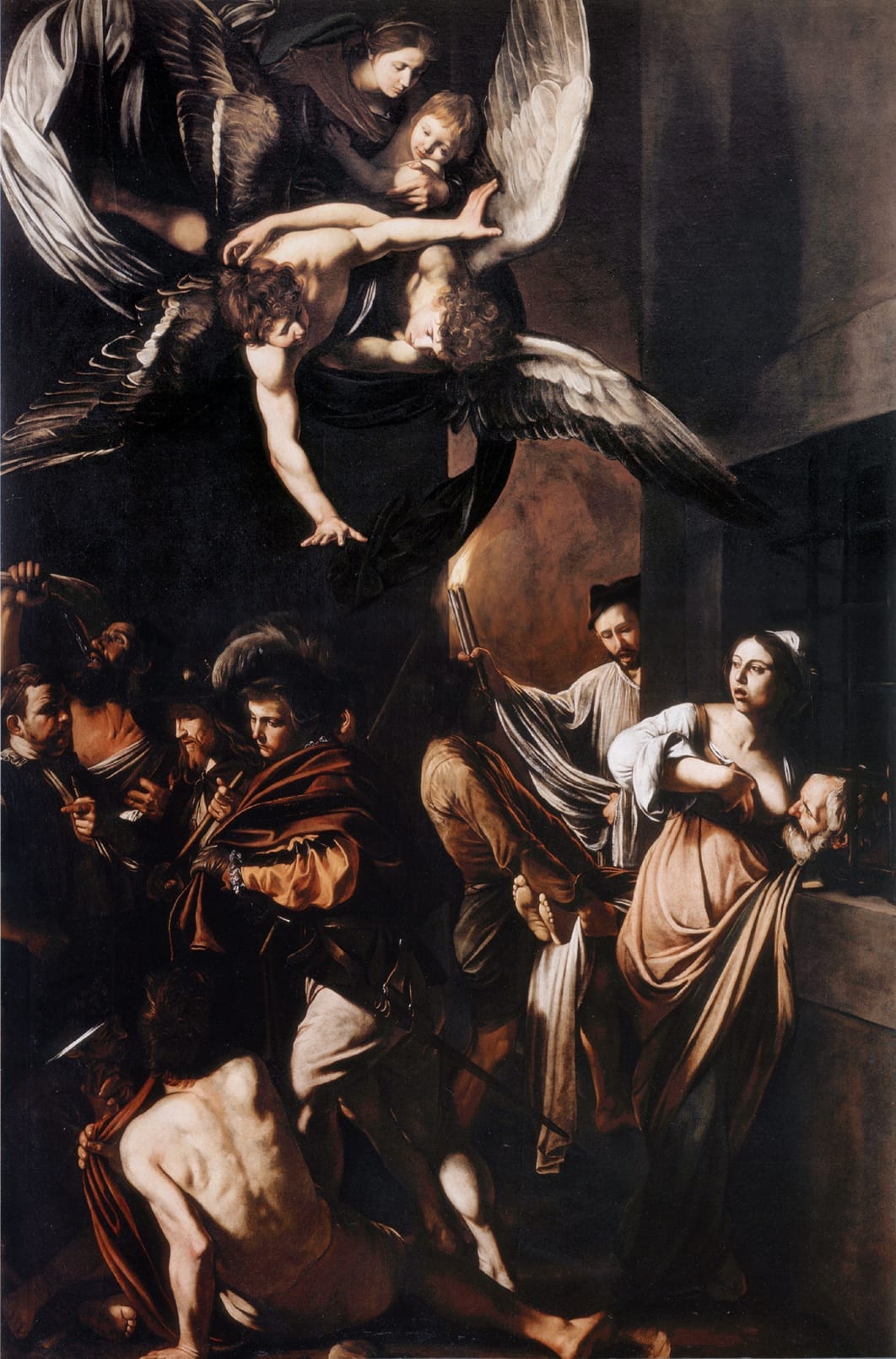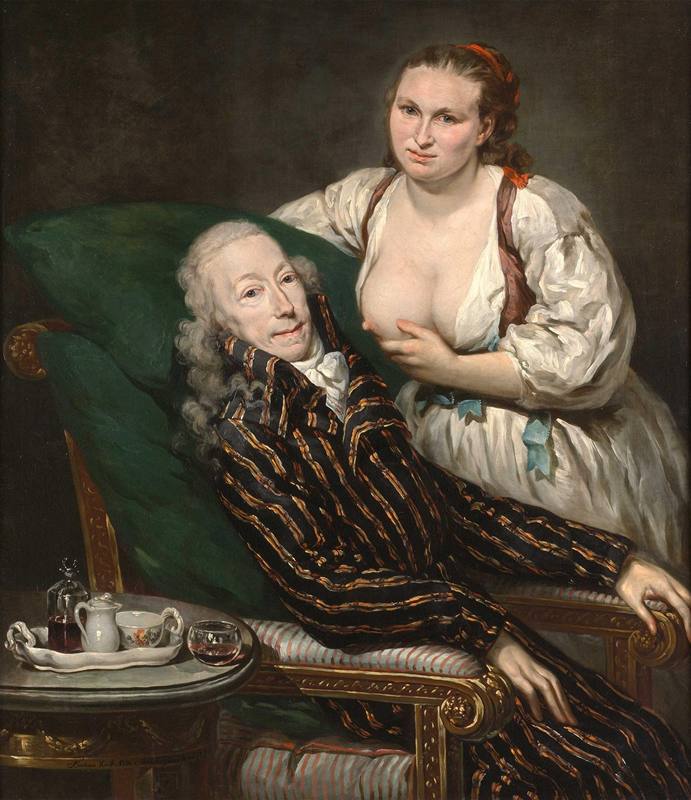Katrina Genuis
Vancouver, Canada
 |
| Pero and Cimon Fresco, 50 to 79 CE, unknown artist, Pompeii, Casa IX. Copyright of photograph attributed to Stefano Bolognini. |
Two thousand years ago, the Roman writer Valerius Maximus documented a particularly strange set of events. In his collection Memorable Doings and Sayings, Maximus recounts thousands of episodes of exemplary Roman behavior. One of these is the tale of a woman, Pero, and her father, Myco (also called Cimon). In the brief narrative, Myco is condemned to starve in prison but Pero, visiting and seeing her father “a man in extreme old age” starving in filth, puts him “like a baby to her breast and [feeds] him.” This story is not an anomaly; there is a similar story of an unnamed daughter who feeds her condemned mother “with the succour of her own milk.” The board of judges arbitrating the mother’s case observe this act of piety and struck by the “novel and remarkable spectacle,” forgive the mother’s sentence.1
While for Maximus the focus of these tales was the remarkable love between a daughter and parent, one cannot help but feel surprise at the explicit description of filial breastfeeding. Maximus even acknowledges this paradoxical reaction, offering that “This might be thought to be against nature, if to love parents were not Nature’s first law.” 2 In its strange magnetism, the image of a daughter breastfeeding a parent, a motif now referred to as Roman Charity, has captured artists’ imaginations and made its way into more than three hundred works of visual and written art from the first century to the present day.3 Perhaps it is directly because of its peculiarity that the image of filial breastfeeding has persisted; it surprises and estranges us from the familiar human body, opening space for re-awakened wonder at the human capacity to nourish and care for one another in all manner of circumstances.
About the same time period that Maximus’ works were written, widespread visual, literary, and architectural artwork honoring the act of filial breastfeeding also appeared. One fresco from Pompeii (Figure 1), reveals an emaciated elderly man grasping on to a woman and suckling her breast. The seated woman looks relaxed and gazes tenderly towards the man she is feeding. As is the case here, visual artwork depicting Roman Charity almost always portrays a daughter feeding a father rather than a mother. In addition to frescos, the image is found in Egyptian terracotta sculptures, ceramics, and many literary works of the time. Perhaps most impressively, an entire temple was created and dedicated to the Goddess of Piety on the supposed prison site of the event, in honor of the daughter’s act.4
 |
| Roman Charity, 1630, Peter Paul Rubens, Rijksmuseum, Amsterdam. |
Filial breastfeeding was honored not only because it was regarded as an act of remarkable love but also because breast milk was thought to have near-miraculous nourishing capacities. Pliny the Elder writes in the Natural History (77 C.E.) that the act of a daughter breastfeeding a starving parent shows “marvelous affection” and he implies that the substance has particular healing qualities. He relates, for example, how certain concoctions and applications of human milk prevent disease, writing that “It is asserted that one who has been rubbed with the milk of mother and daughter together never needs to fear eye trouble for the rest of his life.”5
The medical benefits of breast milk suggested by Pliny are impressive, but other writings far supersede his claims. Some works even ascribe it supernatural powers. For example, breast milk features prominently in Greek and Roman religious legends in which “gods and heroes, were commonly, and very spectacularly, not nursed by their mothers: Heracles achieved immortality by ingesting drops from Juno’s milk; Jupiter was raised by Amalthea, the she-goat; and wild animals suckled the powerful heroines in Hyginus’ fables.” While not all early descriptions of breast milk extol its benefits (Aristotle considered it to be externalized menses while Galen famously described it as “benign and useful excrement”), breastfeeding was widely regarded as a pious and powerful act. Given these foundational societal myths, it is clear why breast milk given to a starving prisoner was regarded as a salvific physical and spiritual gift.6
Leaping forward to the seventeenth century, many painted images of filial breastfeeding were incorporated into new artistic and religious traditions with widely disparate styles of depiction. Some images exude piety and self-sacrifice, similar to the sentiments of the Roman narrative, while others distinctly evoke drama, desperation, or eroticism. In Peter Paul Rubens’ 1630 version of Roman Charity (Figure 2), Pero’s appearance is accentuated; both breasts are bare as she voluptuously looks over her shoulder, highlighting her finely-braided golden hair and bright red lips. Gawking soldiers peer through the window and we sense that — counter to Maximus’ version — the observers are not simply struck by the piety of the act.
 |
|
The Seven Works of Mercy, 1607, Michelangelo da Caravaggio, Pia Monte della Misericordia, Naples. |
In Michelangelo da Caravaggio’s 1607 version, Pero’s compassion is emphasized; Pero and Myco are anachronistically painted into a collection of images portraying the seven great works of mercy of Catholic theology (Figure 3). Their story bears witness to the great acts visiting the imprisoned and feeding the hungry. This Pero looks on-guard, attentive to her father, and afraid. With modest coverings, her revealed breast is obscured in the shadows. The dramatically self-sacrificial nature of the act and the personal risk involved for Pero are emphasized.
A final image, radically different from the previously discussed versions, is Barbara Krafft’s 1797 rendition (Figure 4). Here, father and daughter have absconded the prison setting and are instead in a drawing room. The father is pale and thin, similar to other versions, but also wealthy, resting bundled up in a gold-leaf armchair and propped up on fine dark green cushions. Beside the father is a tea tray containing a bottle of medicine or alcohol and a partly emptied glass, implying the father’s capacity to drink normally. Both father and daughter look out, aware of their audience. The father smiles slightly, as if inviting observation as his daughter leans in to feed, while the daughter gazes impersonally, perhaps even reluctantly at the viewer. This is one of the most uncomfortable depictions of Roman Charity, capturing all its awkward ambiguity. Without the prison backdrop, visible parental desperation, or the pretense of starvation, the act of a daughter breastfeeding a father seems unquestionably transgressive.
In all its complexity, this story retains a strange emotive force and continues to be represented in contemporary visual art and literature. Perhaps the most famous recent reanimation of this ancient story is in the final paragraphs of John Steinbeck’s Pulitzer Prize winning 1939 novel Grapes of Wrath. The book follows various experiences of members of the impoverished Joad family through the Great Depression.
In the final chapter of the book, Rose of Sharon gives birth to a stillborn baby in the family’s boxcar home during a storm. Soon after, when flooding from the rain begins, the family is forced to climb to higher ground and escapes the rain in an old barn. There they find an ill and starving middle-aged man and his son. The man is unable to swallow solids and the son begs them for “money to git milk,” exclaiming “He’s dyin’, I tell you! He’s starvin’ to death, I tell you.” Hearing this despairing plea, Ma and Rose of Sharon make eye contact and gaze “deep into each other.” Then, sending everyone else out, the exhausted Rose of Sharon, only days past her tragic labor, lays down beside the man. She encourages him not to feel any shame, urging “You got to,” and pulling his weak head close to her breast. As he begins to feed, the book concludes on a final note of ecstatic tranquility: Rose of Sharon “looked up and across the barn, and her lips came together and smiled mysteriously.”7
 |
| Roman Charity, 1797, Barbara Krafft, National Gallery in Prague |
Following the long journey with the Joad family, burdened by injustice, division, and death, the reader is profoundly moved by this final act of kinship and self-sacrificial love towards a stranger. The oddness of the act is overshadowed by the man’s otherwise hopeless circumstance. He seemingly had a specific need that only Rose of Sharon’s milk, given willingly and compassionately, could alleviate. This act embodies the dual nourishment inherent to breastfeeding: sustenance to the body and relational nourishment of the soul.
Contemporarily, most representations of breastfeeding involve a mother and child. These images tend to be unified in tone, comfortingly sentimental and familiar to our sensibilities. Representations of filial breastfeeding are neither comfortable nor familiar. In their alterity, they have a unique capacity to provoke opposing responses. They explicitly shock, perhaps even disgust, yet in some cases are also deeply moving. We are reminded that humans exist not as consumers alone, but as creative carers and bodily providers of sustenance to those who are most vulnerable.
In distancing us from the familiar, Roman Charity fosters a renewed awe for the human body’s capacity to nourish. The significance of breastfeeding, both physically and relationally, is reincarnated in these images and stories. Despite our renewed appreciation for the human body’s miraculous capacities, we may prefer to maintain the societal norm of breastfeeding as an exclusively maternal practice and, unlike Valerius Maximus, regard this body of artwork as a tool for inspiration through estrangement rather than a pious example to follow.
End Notes
- Maximus, Valerius Maximus, Memorable Doings and Sayings, 501.
- Maximus, 501.
- Sperling, Roman Charity, 9.
- Sperling, 239.
- Sperling, 240.
- Sperling, 1–2.
- Steinbeck, The Grapes of Wrath, 618–19.
Bibliography
- Maximus, Valerius. Valerius Maximus, Memorable Doings and Sayings, Volume I: Books 1-5. Translated by R. Shackleton Bailey. Loeb Classic Library. Cambridge: Harvard University Press, 2000.
- Sperling, Jutta Gisela, ed. Medieval and Renaissance Lactations: Images, Rhetorics, Practices. Women and Gender in the Early Modern World. Farnham: Ashgate Publishing Limited, 2013.
- ———. Roman Charity: Queer Lactations in Early Modern Visual Culture. transcript Verlag, 2018.
- Steinbeck, John. The Grapes of Wrath. Harmondsworth: Penguin Books, 2002.
KATRINA GENUIS, M.Litt., MD, is an anesthesiology resident doctor in Vancouver, Canada. She believes that the care of those who are suffering has artistic, philosophical, and theological dimensions, and recently completed a Master’s degree at the Institute for Theology, Imagination and the Arts at the University of St. Andrews. Studied in both medicine and the arts, she explores modes of incorporating the humanities in the holistic care of those who are suffering.
Highlighted in Frontispiece Volume 11, Issue 1– Winter 2019
Fall 2018 | Sections | Food

Leave a Reply